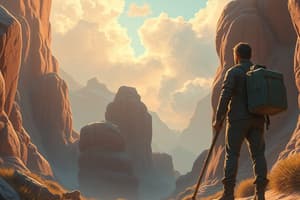Podcast
Questions and Answers
Which shot emphasizes a small area or detail of the subject, such as eyes or mouth?
Which shot emphasizes a small area or detail of the subject, such as eyes or mouth?
- Cut-In
- Cut Away
- Extreme Close Up (correct)
- Two Shot
What type of shot shows two people, with one in the foreground and the other in the background?
What type of shot shows two people, with one in the foreground and the other in the background?
- Reverse Angle Shot
- Cut Away
- Selective Focus
- Two Shot (correct)
Which type of shot is used to present a conversational back and forth between two subjects?
Which type of shot is used to present a conversational back and forth between two subjects?
- Over the Shoulder (correct)
- Point of View
- High Angle
- Reaction Shot
What shot is taken from a 180 degrees angle opposite to the previous shot?
What shot is taken from a 180 degrees angle opposite to the previous shot?
Which type of shot shows a character's reaction to the preceding shot?
Which type of shot shows a character's reaction to the preceding shot?
What type of camera angle looks down on the subject from a high angle?
What type of camera angle looks down on the subject from a high angle?
Which camera position is set at an angle on its roll axis to show a disoriented or uneasy psychological state?
Which camera position is set at an angle on its roll axis to show a disoriented or uneasy psychological state?
'Worm's Eye View' refers to a shot that is looking up from which perspective?
'Worm's Eye View' refers to a shot that is looking up from which perspective?
What type of shot emphasizes a small area or detail of the subject, such as the eyes or mouth?
What type of shot emphasizes a small area or detail of the subject, such as the eyes or mouth?
Which camera angle is positioned directly overhead, looking down at the scene from a higher point?
Which camera angle is positioned directly overhead, looking down at the scene from a higher point?
What type of shot interrupts a continuous shot by inserting a shot of something else?
What type of shot interrupts a continuous shot by inserting a shot of something else?
Which camera angle is positioned below the eyeline, pointing upward?
Which camera angle is positioned below the eyeline, pointing upward?
What type of shot shows what a character is looking at without showing its reaction?
What type of shot shows what a character is looking at without showing its reaction?
Flashcards
Extreme Close Up
Extreme Close Up
A shot that focuses on a very small area or detail of the subject, like eyes or mouth.
Two Shot
Two Shot
A shot showing two people, with one usually in the foreground and the other in the background.
Over the Shoulder
Over the Shoulder
A shot used to show a conversation between two subjects, where the camera is positioned behind one character, looking over their shoulder at the other.
Reverse Angle Shot
Reverse Angle Shot
Signup and view all the flashcards
Reaction Shot
Reaction Shot
Signup and view all the flashcards
High Angle
High Angle
Signup and view all the flashcards
Dutch Angle/Tilt
Dutch Angle/Tilt
Signup and view all the flashcards
Worm's Eye View
Worm's Eye View
Signup and view all the flashcards
Bird's Eye View
Bird's Eye View
Signup and view all the flashcards
Cut Away
Cut Away
Signup and view all the flashcards
Low Angle
Low Angle
Signup and view all the flashcards
Point of View
Point of View
Signup and view all the flashcards
Study Notes
Camera Angles and Shots
- Full Screen Shot: A close-up shot of a subject's face, showing the entire face.
- Choker: A shot that frames the subject's face from above the eyebrows to below the mouth.
- Extreme Close Up: Emphasizes a small area or detail of the subject, such as eyes or mouth.
Shot Types
- Two Shot: A shot that encompasses two people, who don't have to be next to each other.
- Cut Away: An interruption of a continuous shot by inserting a shot of something else.
- Cut-In: Similar to a cut away, but shows a close-up shot of something visible in the main scene.
- Over the Shoulder: The camera is placed above the back of the shoulder and head of a subject, often used to show conversational back and forth between two subjects.
Perspective and Reaction
- Reverse Angle Shot: A shot taken from a 180-degree angle opposite to the previous shot.
- Reaction Shot: Shows a character's reaction to the shot that has preceded it.
- Point of View: An angle that shows what a character is looking at, without showing their reaction.
Camera Techniques
- Dutch Angle/Tilt: The camera is set at an angle on its roll axis, so that the horizon line is not level, used to show a disoriented or uneasy psychological state.
- Selective Focus: Blurring the background to focus on the foreground image.
- Eye-Level: The camera is placed at the same height as the viewer's eyes, stimulating standard human vision.
Angle and Orientation
- High Angle: The camera looks down on the subject from a high angle.
- Low Angle: The camera is positioned anywhere below the eyeline, pointing upward.
- Bird's Eye View: A direct overhead extreme long shot angle that looks down at the scene from a higher point.
- Worm's Eye View: A shot that looks up from the ground.
Studying That Suits You
Use AI to generate personalized quizzes and flashcards to suit your learning preferences.
Description
Test your knowledge on different types of camera shots and angles used in cinematography. Identify the characteristics and purposes of close-up, extreme close-up, two shot, cut away, and cut-in shots.




